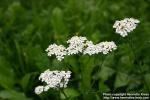Achillea.—Yarrow.

 The whole plant, Achillea Millefolium, Linné.
The whole plant, Achillea Millefolium, Linné.
Nat. Ord.—Compositae.
COMMON NAMES.—Yarrow, Milfoil, Thousand leaf.
ILLUSTRATION: Bentley and Trimen., Med. Plants, 153; Woodville, Med. Bot., 15.
Botanical Source and Description.—Yarrow is a common perennial plant from 1 to 3 feet in height, bearing dark-green, crowded, alternate, bi-pinnatifid leaves. The flowers, which are grayish-white (occasionally rose-colored), are arranged in a flat-top, corymbose head. The odor is peculiar, being pleasantly and highly aromatic, somewhat resembling chamomile. The taste is sharp, bitterish, astringent, and slightly saline.
History.—Yarrow is a common wayside herb, and is also found growing wild in fields, pastures, and waste places throughout the central portions of North America and Europe. It flowers from May to October, during which time it should be gathered (preferably during July), and after rejecting the coarser stems, should be carefully dried. The weight, after drying, is but 15 per cent of the amount collected. The leaves are more astringent than the flowers, the latter being more aromatic than the former. The American plant is said to be more valuable than the European species. Achillea was known to the ancients. Pliny states that the generic term, Achillea, was named from Achilles, a physician, who was one of the first to use a species of this plant as a vulnerary. Yarrow is sold by the native herbalists of India, like rosemary, where it is used as a bitter and in medicated vapor baths for fevers (Dymock). The Italians employed it in intermittent fevers, and in the Scottish highlands it is made into ointment for wounds. According to Linnaeus the Dalecarlians used it as a substitute for hops in the making of ale, believing it to impart to it intoxicating qualities. Both Stahl and Haller used this plant extensively.
Chemical Composition.—Yarrow contains a reddish-brown, active, bitter principle called achillein (C20H38N2O15), discovered by Zanon, in 1846 (Liebig's Annalen), and shown by Von Planta (1870) to be alkaloidal and identical with the achilleine of Achillea moschata. Zanon also found an acid which he named achilleic acid, and which was subsequently (1857) shown by Hlasiwetz to be aconitic acid. A small portion of a volatile oil, dark-green in color, may be obtained from yarrow by distillation with water. Milfoil also contains potassium and calcium salts, resin, gum, and tannin.
Action, Medical Uses, and Dosage.—Yarrow possesses slightly astringent properties, and is tonic, alterative and diuretic, in infusion. Its use in chronic diseases of the urinary apparatus, is especially recommended by Prof. J. M. Scudder. It exerts a tonic influence upon the venous system, as well as upon mucous membranes. It has been efficacious in sore throat, hemoptysis, hematuria and other forms of hemorrhage where the bleeding is small in amount, incontinence of urine, diabetes, hemorrhoids with bloody or mucoid discharges, and dysentery; also in amenorrhoea, flatulency and spasmodic diseases, and in the form of injection in leucorrhoea with relaxed vaginal walls. Prof. T. V. Morrow made much use of an infusion of this herb in dysentery. Given in half-drachm doses of the saturated tincture, or 20-drop doses of specific achillea, it will be found one of our best agents for the relief of menorrhagia.
The active principle, Achillein, has been employed in France and other portions of Southern Europe, as a substitute for quinine in the treatment of intermittent fevers. It has also been employed by French physicians to restore arrested lochial discharges.
Ɣ Of infusion (℥i to Aqua Oj), 1 to 2 fluid ounces; specific achillea, 5 to 30 drops; volatile oil, 5 to 20 drops. All preparations of achillea are rendered more pleasant to the taste by the addition of a few drops of oil of anise.
Specific Indications and Uses.—To relieve urinary irritation, strangury, urinary suppression; relieves irritation in incipient Bright's disease, capillary relaxation, leucorrhoea with relaxed and irritated vaginal walls, hematuria, gastric and intestinal atony, atonic amenorrhoea, menorrhagia.
 Related Species.—Achillea Ptarmica, Linné, Sneezewort. Naturalized in the Eastern States, growing in hedges, thickets, and moist places. The leaves are remarkably distinct from those of yarrow, being lance-linear, sessile, acuminate and serrate. The flowers are white and arranged in a diffuse corymb. Sialagogue and sternutatory.
Related Species.—Achillea Ptarmica, Linné, Sneezewort. Naturalized in the Eastern States, growing in hedges, thickets, and moist places. The leaves are remarkably distinct from those of yarrow, being lance-linear, sessile, acuminate and serrate. The flowers are white and arranged in a diffuse corymb. Sialagogue and sternutatory.
Achillea moschata, Linné. Iva, Musk milfoil. An Alpine plant having the odor of musk, largely used by the Swiss as a sudorific and for its healing qualities. It contains ivaol (C12H20O), a bluish-green or azure, bitterish, mintlike, volatile oil (called Esprit d'Iva, at Engadine, where it is extracted); moschatine (C21H27NO7 ), a nitrogenous body; an alkaloidal principle, achilleine (C20H38N2O15); and ivain (C24H42O3) a yellow, soft bitter, soluble in alcohol.
Upon boiling with dilute acids achilleine yields, besides sugar, ammonia, and an odoriferous principle, achilletine (C11H17NO4), a non-bitter, insoluble, deep-brown body.
Achillea ageratum, Linné. Europe. This species has tufted, clammy leaves and a disagreeable odor and bitter taste. Used occasionally as a medicine.
Achillea nobilis, Linné. Europe. This pubescent species has a stronger taste and odor than common milfoil, and is sometimes used for similar purposes. The Achillea nana, Linné, and Achillea atrata, Linné, both natives of Europe, are likewise employed medicinally, the latter especially for its stimulating effects in the early stages of fevers.

